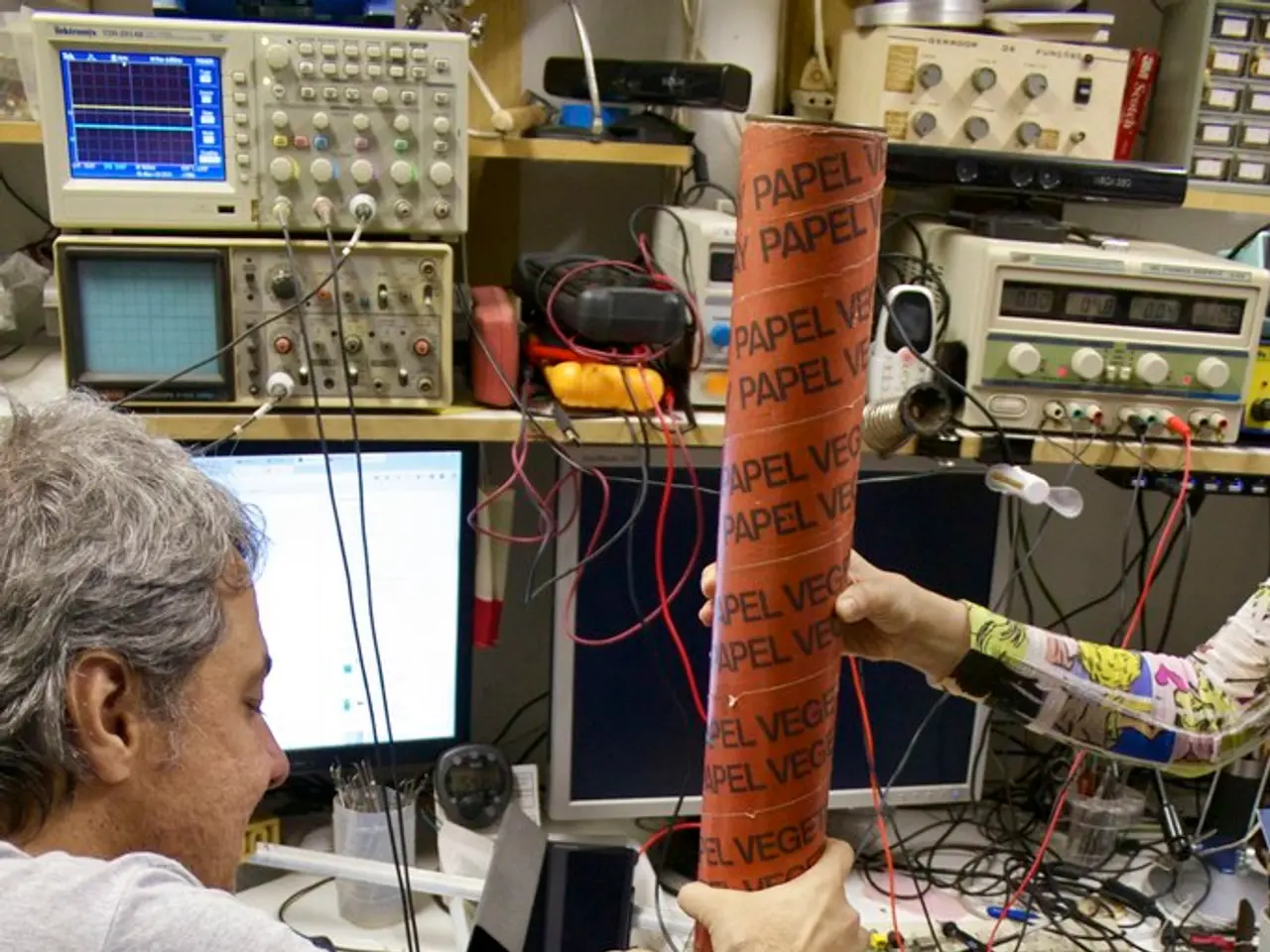Neuron Interaction: An Examination of the Synapse Connection Between Two Neurons
Juiced-Up Communication:
Get ready to dive deep into the fascinating world of synapses, where a wild dance of neurons happens, basically without touching each other. That's right, communication in your brain is more like a game of charades than a handshake!
Here's the lowdown: A synapse is like a junction where one excited neuron sends a message to another. It consists of the excited neuron's axon terminal, a tiny gap called the synaptic cleft, and the salvation (or doom) for the next neuron – its dendrite or cell body.
The message is not passed through a laser beam or Morse code; instead, it's carried by chemical messengers called neurotransmitters. Terminal buttons at the ends of neurons house these green-room heroes, filled with neurotransmitters ready to take the stage.
When the action potential, or the electric signal, reaches these terminal buttons, it triggers them to release their neurotransmitters into the synaptic cleft. Like a cheerleader rallying the team, the neurotransmitters go on to bind with receptors on the next neuron, effectively passing the baton.
Neurons, being social butterflies, often receive signals from several terminal buttons, and each one of those can form synapses with multiple neurons, building a complex neural network.
How Neurons Ad lib: Synaptic Transmission
Synapses are the lifeblood of systemic neural activity. Fast forward to our history books (neuroscience textbooks), and we see that synapses play a starring role in a multitude of cognitive functions, such as learning, memory formation, and pretty much anything that makes you, well, you.
There are two types of synapses: chemical and electrical. In the case of chemical synapses, information flows through neurotransmitters in four simple steps:
- The wired-up neuron’s terminal receives the action potential, triggering it to eject neurotransmitters into the cleft.
- The ejected neurotransmitters cross the synaptic gap and bind to receptors on the receiving neuron.
- The receiving neuron takes that chemical signal, converts it back to an electric one.
The effect can be like a rock star cranking up the amplifiers (excitatory, amping up the next neuron) or pushing that pesky fan way back (inhibitory, dampening the next neuron's excitement).
Common excitatory neurotransmitters include noradrenaline, while serotonin can have inhibitory effects.
The secret sauce behind neurotransmitter release? Calcium (Ca2+). Think of this ions as the keys, unlocking the door to vesicles brimming with neurotransmitters. Here's how it goes down:
- When an action potential approaches a neuron, it opens special "voltage-gated calcium channels" in the cell membrane.
- Calcium floods into the neuron through these channels, increasing its concentration.
- Inside the neuron, calcium binds to special proteins on synaptic vesicles, causing them to fuse with the cell membrane and release their neurotransmitters into the synaptic cleft.
Time for a Standing Ovation: Electrical Synapses
Electrical synapses, though rare, are wholly different from their chemical counterparts. Replacing the grand theater with a backstage corridor, electrical synapses use direct connections called gap junctions – protein channels that connect two neurons.
This allows electrical signals to flow directly between cells, making transmission nearly instantaneous. While incredibly fast, these connections can only excite the next neuron and their signals weaken over distance.
The Moment of Truth: Neurons' Decision-making Process
Neurons, being exposed to a barrage of signals, need to make decisions about whether to fire based on their combined effect. This process, called summation, can occur through spatial summation (different signals arriving at the same place and time) or temporal summation (different signals arriving at different times).
Excitement vs. Indifference: Excitatory vs. Inhibitory Signals
The pre-synaptic neuron's effect on the post-synaptic neuron can be either stimulating (excitatory) or stifling (inhibitory). Chemicals released by the presynaptic neuron may either excite the postsynaptic neuron, increasing its likelihood to fire, or inhibit it, decreasing that likelihood.
The Recycling Program: Neurotransmitter Reuptake
For a synapse to function effectively, it must be shut off once the signal is sent; post-synaptic neurons need to return to their resting state and be ready for new signals. This signal termination is made possible by reuptake, breakdown or diffusion of neurotransmitters.
Reuptake is when neurotransmitters are reabsorbed back into the presynaptic neuron that released them initially. Transporter proteins from the presynaptic membrane remove the neurotransmitters from the synaptic cleft and carry them back into the presynaptic neuron.
- The promiscuous serotonin is often associated with various psychological and bodily functions, like mood, sexual desire, appetite, sleep, and memory. If there are imbalances in the way it's transmitted between neurons, it can contribute to mood disorders, specifically depression.
- Selective serotonin reuptake inhibitors, or SSRIs, are a class of medications that work to counteract these imbalances. By blocking neurotransmitter reuptake, SSRIs make more serotonin available in the synaptic cleft, potentially improving mood and easing emotional regulation.
The Long and Winding Synapse: Synaptic Dysfunction
When synapses don't work properly, the consequences can be severe. Synaptic dysfunction, caused by disrupted neurotransmitter release, faulty receptors, or damaged synaptic structures, has been linked to numerous neurological and psychiatric conditions, including epilepsy, Alzheimer's disease, schizophrenia, and Parkinson's disease.
Molding the Future: Synaptic Plasticity
Synaptic plasticity is the brain's incredible ability to strengthen or weaken synaptic connections based on activity. The more those synapses are used, the stronger they can become and the more they can influence the postsynaptic neuron. On the flip side, neglecting synapses can weaken them, which may have detrimental long-lasting effects.
Repeated use of certain pathways can make the connections more efficient, supporting learning, memory, and skill development, as well as the brain's ability to adapt after injury or in response to new experiences.
Frequently Asked Questions
What are the important neurotransmitters and what do they do?
The brain relies on several key players, including dopamine, serotonin, glutamate, GABA, and acetylcholine, all of which bind to specific receptors to either excite or inhibit the next neuron:
- Dopamine plays a role in reward, motivation, and movement.
- Serotonin regulates mood, appetite, and sleep.
- Glutamate is the brain's primary excitatory neurotransmitter, essential for learning and memory.
- GABA (gamma-aminobutyric acid) is the primary inhibitory neurotransmitter, helping calm neural activity.
- Acetylcholine supports attention, arousal, and muscle activation.
What types of receptors do neurotransmitters bind to?
Neurotransmitters bind to two primary types of receptors:
- Ionotropic receptors, acting like gates – when a neurotransmitter binds, the receptor opens, causing ions to flow directly into the cell, resulting in a quick response.
- Metabotropic receptors, triggering slower, longer-lasting effects by activating internal cell processes via second messengers. The type of receptor determines how a signal affects the postsynaptic neuron.
How do SSRIs work to treat depression?
SSRIs, or selective serotonin reuptake inhibitors, are a class of antidepressants. They work by blocking the reabsorption (reuptake) of serotonin into the presynaptic neuron, allowing more serotonin to remain in the synaptic cleft and potentially improve mood over time.
What role does calcium play in neurotransmitter release?
Calcium ions are crucial to neurotransmitter release through indirect mechanisms:
- When an action potential arrives at the end of a neuron, it triggers voltage-gated calcium channels (VGCCs) to open. This allows calcium ions to flood into the neuron where they activate internal signaling processes, ultimately leading to synaptic vesicle release.
- Calcium's role goes beyond initiating neurotransmitter release; it also impacts neuronal excitability and synaptic plasticity, fundamental for learning and memory.
How do neurons know when to fire a signal?
Neurons receive multiple signals, some stimulating and others stifling, forcing those cells to decide whether to fire based on their relationship. This decision-making process, known as summation, can occur through spatial summation or temporal summation.
Sources:
- Nishiyama, T., & Uchida, N. (2017). Signaling mechanisms in synaptic plasticity by ion-regulated ion channels and transporters. Molecular neurobiology, 54(7), 3769-3783.
- Bien-Ly, N., & Kandel, E. R. (2013). Molecular mechanisms of learning and memory. Annual review of cell and developmental biology, 29, 103-129.
- Bergles, D. E., & Brown, E. N. (2011). Transmembrane protein responses to injury and disease. Annu Rev Biophys, 40, 141-164.
- Zamponi, G. W., &Changeux, J.-P. (2003). Calcium signaling in synaptic transmission and plasticity. Physiological Reviews, 83(4), 1529-1576.
- Shen, W., & Brandon, M. W. (2013). Role of voltage-gated calcium channels in synaptic physiology and plasticity. Physiology, 28(3), 156-168.
- Communication in the mind, like a wild dance of neurons, happens across synapses, junctions where excited neurons send messages without touching each other.
- The process of synaptic transmission is like a game of charades, where the messengers, neurotransmitters, are the green-room heroes.
- In the system of neural activity, synapses play a crucial role in cognitive functions such as learning, memory formation, and overall personality development.
- There are two types of synapses: chemical and electrical, both essential for the proper functioning of the brain and health-and-wellness.
- Depression can arise from imbalances in the transmission of serotonin, a neurotransmitter often associated with psychological and bodily functions like mood, appetite, sleep, and memory.
- Research has discovered that selective serotonin reuptake inhibitors, or SSRIs, work to counteract these imbalances, potentially improving mood and easing emotional regulation.
- Disrupted neurotransmitter release, faulty receptors, or damaged synaptic structures can lead to synaptic dysfunction, connected to numerous disorders like epilepsy, Alzheimer’s disease, schizophrenia, Parkinson’s disease.
- The brain's ability to strengthen or weaken synaptic connections based on activity is called synaptic plasticity, which plays a significant role in skill development, fitness-and-exercise, and nutrition-related learning processes.
- Properly understanding the synapse and its role in the brain can lead to innovative treatments and further advancements in neuroscience, psychology, and overall wellbeing.







